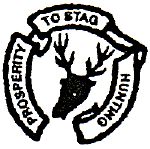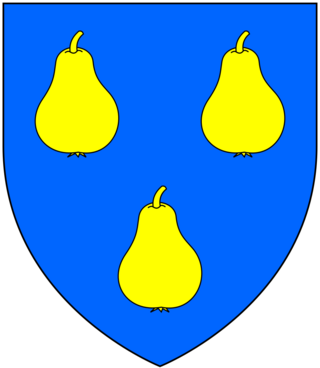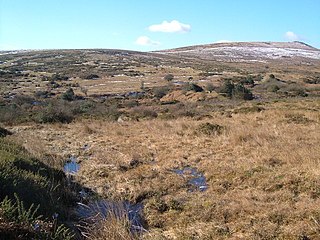
Tristram Risdon was an English antiquarian and topographer, and the author of Survey of the County of Devon. He was able to devote most of his life to writing this work. After he completed it in about 1632 it circulated around interested people in several manuscript copies for almost 80 years before it was first published by Edmund Curll in a very inferior form. A full version was not published until 1811. Risdon also collected information about genealogy and heraldry in a note-book; this was edited and published in 1897.

Sir Thomas Dyke Acland, 7th Baronet of Killerton in Devon and Petherton Park in Somerset, was Member of Parliament for Devon, 1746–1747, for Somerset, 1767–1768, and was High Sheriff of Somerset in 1751. He was a prominent member of the West Country gentry, and a famous staghunter who used as his hunting seats his wife's Exmoor estates of Pixton and Holnicote.

Escot in the parish of Talaton, near Ottery St Mary in Devon, is an historic estate. The present mansion house known as Escot House is a grade II listed building built in 1837 by Sir John Kennaway, 3rd Baronet to the design of Henry Roberts, to replace an earlier house built in about 1680 by Sir Walter Yonge, 3rd Baronet (1653–1731) of Great House in the parish of Colyton, Devon, to the design of Robert Hooke, which burned down in 1808. Today it remains the home of the Kennaway baronets.

Sir Henry Ford, of Nutwell in Devon was four times MP for Tiverton between 1664 and 1685 and twice Secretary to the Lord Lieutenant of Ireland, 1669–70 and 1672–73.

The red deer of Exmoor have been hunted since Norman times, when Exmoor was declared a Royal Forest. Collyns stated the earliest record of a pack of Staghounds on Exmoor was 1598. In 1803, the "North Devon Staghounds" became a subscription pack. In 1824/5 30 couples of hounds, the last of the true staghounds, were sold to a baron in Germany. Today, the Devon and Somerset is one of three staghounds packs in the UK, the others being the Quantock Staghounds and the Tiverton Staghounds. All packs hunt within Devon and Somerset. The Chairman as of 2016 is Tom Yandle, who was previously High Sheriff of Somerset in 1999.

Heanton Satchville was a historic manor in the parish of Petrockstowe, North Devon, England. With origins in the Domesday manor of Hantone, it was first recorded as belonging to the Yeo family in the mid-14th century and was then owned successively by the Rolle, Walpole and Trefusis families. The mansion house was destroyed by fire in 1795. In 1812 Lord Clinton purchased the manor and mansion of nearby Huish, renamed it Heanton Satchville, and made it his seat. The nearly-forgotten house was featured in the 2005 edition of Rosemary Lauder's "Vanished Houses of North Devon". A farmhouse now occupies the former stable block with a large tractor shed where the house once stood. The political power-base of the Rolle family of Heanton Satchville was the pocket borough seat of Callington in Cornwall, acquired in 1601 when Robert Rolle purchased the manor of Callington.

The landed gentry and nobility of Devonshire, like the rest of the English and European gentry, bore heraldic arms from the start of the age of heraldry circa 1200–1215. The fashion for the display of heraldry ceased about the end of the Victorian era (1901) by which time most of the ancient arms-bearing families of Devonshire had died out, moved away or parted with their landed estates.

The feudal barony of Bampton was one of eight feudal baronies in Devonshire which existed during the mediaeval era, and had its caput at Bampton Castle within the manor of Bampton.
William Thomson (1746–1817) was a Scottish minister, historian and miscellaneous writer. He often wrote under the pseudonym of Captain Thomas Newte and this fictitious character had his own history and received independent recognition.

John Crocker Bulteel (1793–1843) of Fleet, Holbeton, in South Devon, was a Whig MP for South Devon 1832-4 and was Sheriff of Devon in 1841. He was Master of the Dartmoor Foxhounds and bred the finest pack of hounds in England.

Peamore is a historic country estate in the parish of Exminster, Devon, which is near the city of Exeter. In 1810 Peamore House was described as "one of the most pleasant seats in the neighbourhood of Exeter". The house was remodelled in the early 19th century and is now a grade II listed building.
Matford is an historic estate in the parish of Alphington, near Exeter, Devon. It should not be confused with Matford in the parish of Heavitree, almost immediately opposite on the other side of the River Exe.
Tom Yandle of Riphay, Brushford, near Dulverton in Somerset, England, is a farmer and chairman of the Devon and Somerset Staghounds and was High Sheriff of Somerset in 1999 and a committee member of both the National Trust and Exmoor National Park. He played a leading role in challenging both the National Trust's decision to ban stag hunting on the Holnicote Estate and the Labour government's ultimately successful proposal to ban hunting with hounds. The Yandle family was previously resident at nearby Duvale an historic estate in the parish of Bampton, Devon. In 1994 he purchased Northmoor House near Dulverton, and 100 acres of surrounding land, which he later sold.

Sir Hugh Stucley (1496–1559) was the lord of Affeton in Devon, and Sheriff of Devon in 1545. His third son was Thomas Stukley, known as "The Lusty Stucley".

Lyneham in the parish of Yealmpton in Devon, is an historic estate. The surviving grand mansion house known as Lyneham House is a grade I listed building. It was built c.1699-1703 by Sir Courtenay Croker, MP for Plympton Morice in 1699. A drawing of Lyneham House dated 1716 by Edmund Prideaux (1693–1745) of Prideaux Place, Padstow, Cornwall, survives at Prideaux Place. It shows formal gardens in front with flanking pavilions and an orangery.

Richard Crocker of Devon, England, was a Member of Parliament for Tavistock in Devon in 1335. His descendants were the prominent Crocker family of Crocker's Hele in the parish of Meeth, Devon, later seated at Lyneham in the parish of Yealmpton, Devon until 1740.

William Crocker, living during the reign of King Edward III (1327-1377), of Crocker's Hele in the parish of Meeth, Devon, was a Member of Parliament. His descendants were the prominent Crocker family seated at Lyneham in the parish of Yealmpton, Devon until 1740. William Crocker is the earliest member of the family recorded in the Heraldic Visitations of Devon, although one of his ancestors is known to have been Richard Crocker (fl.1335) of Devon, England, a Member of Parliament for Tavistock in Devon in 1335.
The manor of Hillersdon was a historic manor in the parish of Cullompton, Devon, England which was held by the de Hillersdon family from the 13th century until the early 16th century. It was then held by a number of different families including the Cockeram, Cruwys and Grant families. Hillersdon House was built in the nineteenth century by the Grant family and is still in use.

Hareston is an historic estate in the parish of Brixton, about three miles from Plymouth in Devon. The mansion house built during the reign of King Henry VII (1485-1509) burned down partially in an accidental fire at the beginning of the 18th century, and in 1822 the surviving part, the Hall and Chapel, was being used as a farmhouse. It was described by Candida Lycett Green in her 1991 book The Perfect English Country House as: "The most forgotten Manor House Farm In England, untouched for hundreds of years, sits safely, impossible to find, down miles of private sunken lanes which in the spring brim with Campion, Bluebells, Purple Orchids, Primroses, Violets, Speedwell and Stitchwort. Wooded hills rise behind this, the quintessence of an ancient English Manor House".

Bagtor is a historic estate in the parish of Ilsington in Devon, England. It was the birthplace of John Ford the playwright and poet. The Elizabethan mansion of the Ford family survives today at Bagtor as the service wing of a later house appended in about 1700.



















